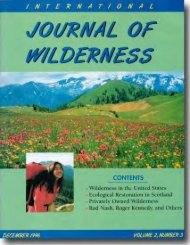Download full PDF - International Journal of Wilderness
Download full PDF - International Journal of Wilderness
Download full PDF - International Journal of Wilderness
Create successful ePaper yourself
Turn your PDF publications into a flip-book with our unique Google optimized e-Paper software.
for a two-course sequence (a one-credit<br />
classroom course and a two-credit field<br />
internship) was accepted, and I began<br />
teaching the classroom course during<br />
the 1994 spring term. I have taught the<br />
sequence annually since.<br />
Each course may be taken for either<br />
forestry or geography academic<br />
credit. The one-credit spring term<br />
course, Forestry/Geography 195WC:<br />
The <strong>Wilderness</strong> Concept and the<br />
Three Sisters <strong>Wilderness</strong>, introduces<br />
the concept <strong>of</strong> wilderness and the<br />
management principles and issues associated<br />
with applying that concept to<br />
National <strong>Wilderness</strong> Preservation System<br />
(NWPS) units. It surveys the<br />
nearby Three Sisters <strong>Wilderness</strong> as a<br />
basis for application <strong>of</strong> these principles<br />
and discussion <strong>of</strong> these issues. The<br />
course provides an academic introduction<br />
to wilderness management and<br />
orientation for service to and enjoyment<br />
<strong>of</strong> wilderness. Usually an elective,<br />
the course is required for students<br />
in the recreation leadership associate’s<br />
degree and transfer programs.<br />
Supported by a small grant from the<br />
college, I wrote and published a 164page<br />
book, The <strong>Wilderness</strong> Concept and<br />
the Three Sisters <strong>Wilderness</strong> (ISBN 0-<br />
9647167-3-9, <strong>Wilderness</strong> Associates<br />
2000) in April 2000. The course textbook<br />
is geared for students, but serves<br />
a general readership as well (see review<br />
in this issue <strong>of</strong> IJW).<br />
The content <strong>of</strong> this course has been<br />
adapted to other instructional situations.<br />
In June 1995, for example, it was<br />
used as the basis <strong>of</strong> a three-day wilderness<br />
ranger training program I conducted<br />
for the Deschutes, Willamette,<br />
and Mt. Hood National Forests. And<br />
in the spring <strong>of</strong> 1998 I presented a<br />
noncredit version <strong>of</strong> the course at the<br />
Sunriver Nature Center. The spring<br />
term classroom course is a good recruiting<br />
and training venue for student<br />
interns who serve as wilderness infor-<br />
mation specialists. Students<br />
who complete the<br />
course with a grade <strong>of</strong> “B”<br />
or better and gain the<br />
permission <strong>of</strong> the instructor<br />
may enroll in the<br />
two-credit summer sequel,<br />
<strong>Wilderness</strong> Internship.<br />
These student<br />
interns, who also sign a<br />
USFS volunteer agreement,<br />
are integrated into<br />
the wilderness information<br />
specialist team and<br />
complete a minimum <strong>of</strong><br />
72 hours <strong>of</strong> supervised<br />
wilderness service.<br />
This combination <strong>of</strong><br />
classroom instruction and<br />
field service may be<br />
adapted in areas throughout<br />
the United States<br />
where colleges are close to<br />
wilderness areas. The wilderness<br />
course syllabus<br />
and the textbook mentioned<br />
above might also<br />
be useful templates for developing<br />
similar courses and books at other colleges<br />
and wildernesses.<br />
COWEP and <strong>Wilderness</strong><br />
Education in the Future<br />
Effective wilderness education must<br />
occur in urban areas as well as at<br />
wilderness trailheads and in the wilderness.<br />
Partnerships such as<br />
COWEP can also incorporate additional<br />
community entities and develop<br />
“<strong>of</strong>f-site” urban center wilderness<br />
Volunteer wilderness information specialist at Green Lobos Trailhead Information<br />
Station. Photo by Les Joslin.<br />
education programs targeted at user<br />
populations. Although visitors to the<br />
Three Sisters <strong>Wilderness</strong> and other<br />
central Oregon units <strong>of</strong> the NWPS<br />
come from all over the Pacific Northwest,<br />
the United States, and many foreign<br />
countries, visitors to this<br />
wilderness, like most others, are primarily<br />
residents <strong>of</strong> the nearby region.<br />
Across the nation, wilderness education<br />
will most likely remain a community-based<br />
effort, and this is logical.<br />
With national and regional guidance,<br />
each national forest and ranger district<br />
Effective wilderness education must occur in urban<br />
areas as well as at wilderness trailheads and in the<br />
wilderness.<br />
<strong>International</strong> <strong>Journal</strong> <strong>of</strong> <strong>Wilderness</strong> DECEMBER 2000 • VOLUME 6, NUMBER 3 29










